Where
Description
This project was undertaken as part of the Salmons Brook Healthy River Challenge, an initiative designed to improve water quality in the Salmons Brook and its tributaries by tackling urban diffuse pollution. Enfield has a predominantly separate sewage system, meaning that surface water and wastewater are carried in two separate pipes. However, pollutants can enter the surface water network, and subsequently watercourses in a number of different ways. Misconnected plumbing contributes phosphates, nitrates and coliform bacteria etc., road run-off inputs oils and heavy metals such as zinc and copper, and household and industrial waste is dumped into surface water drains. This pollution is particularly evident during dry periods when there is little rain to dilute misconnection flows (see figure 1)
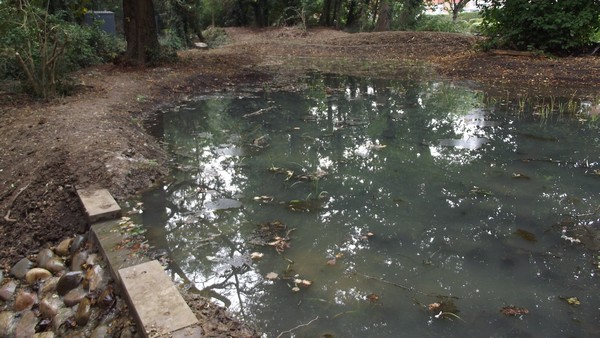 |
| Figure 1. Impact of misconnections |
The Glenbrook is a tributary of the Salmons Brook in Enfield, North London. The stream receives surface water from an urban catchment of 42ha, most of which is paved or tarmac. It flows through underground pipes for much of its length and when it first emerges above ground it is already very badly polluted. For the first 300m of its length above ground the Glenbrook flows through an area of greenspace between minor residential roads and into Boxers Lake. Integrated constructed wetlands (ICW) were created in this greenspace to filter pollutants from the stream.
SuDS components used
- Wetlands
- Swales
Six linked wetlands were created in summer 2014 to filter pollutants from the stream. The flow is directed through each wetland, being successively cleaned as it is slowed through the basins. The basins were planted with both plugs and, more successfully, pre-planted coir mats containing a mix of wetland species such as reeds, rushes, sedges, iris, and kingcup. These were chosen for their pollution removal, ecological and aesthetic value. The plants remove nutrients from the water and stop them polluting the stream. Bacteria in the soil and root systems break down oils and heavy metals.
The system is designed so that in low flow conditions a series of weirs direct all base flow into the wetlands, whilst in high flow conditions a large proportion of the flow continues downstream and only the first flush is treated.
In addition, 15 gullies have been blocked and runoff from the roads redirected into the wetland treatment system through a series of swales.
Now established the planted wetlands not only clean the water, they also add a new dimension to the habitat mosaic for wildlife, and give interest and colour for those passing by.
How it works
The flow and volume of storm water entering the stream is unpredictable depending on the intensity and duration of rainfall. The collection and treatment of the contaminated runoff is undertaken based on sustainable drainage principles but also uses ICW techniques to provide a robust and proven treatment process.
The system begins with a constructed wetland that intercepts day to day low flows, removing both physical debris and the first volume of polluted runoff. Water flows slowly through the wetland where it receives initial cleaning. The runoff is returned to the stream at the end of this first wetland.
There are a series of similar wetlands along the route of the stream before it enters Boxers Lake and during periods of low flow all polluted runoff passes slowly through each wetland in sequence.
As the flow and volume of water increases water will overtop the diverter weir at the inlet of the first wetland and flow down the stream to the second. When the second wetland is full of water it will overflow at the inlet and pass onwards to the third and so on. This process will continue until all wetland basins are full and water will pass directly along the stream to the lake.
The volume stored within the basins is estimated to be the first 10-15mm depth of rainfall, often referred to as the ‘first flush’ volume that carries the majority of pollution from hard surfaces. The water that passes through the system after all the basins are full is judged to be substantially cleaner and any remaining pollution is diluted by the heavy rain. The critical pollution load is retained in the first few wetland basins. Once the peak flow of water has passed through the system the wetland chain continues to function with the ‘retention time’ in the wetlands generally exceeding the duration of heavy rain.
The works improved the woodland’s ecological value by opening up the canopy in this wooded area, re-naturalising the stream banks, providing new wetlands and improving the water quality (see figure 2). Therefore as well as an increase in wetland biodiversity ground flora and associated species have become more diverse.
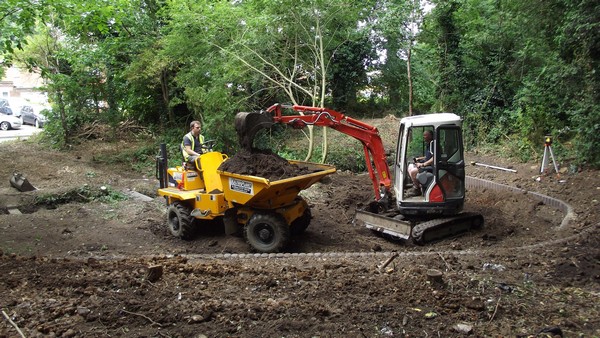 |
| Figure 2. Construction of wetland |
Opening the woodland has also served to reduce fly-tipping and anti-social behaviour and thus make the woodland a better amenity feature. Work is ongoing to improve access and create interpretation for this site. The project has been developed in consultation with the community throughout, as well as additional engagement for volunteer days, pollution prevention and misconnection advice and family fun days centring on wetland and aquatic wildlife. Citizen scientists have been trained, by Thames21, to test water quality and report pollution, and further free training is available to anyone who is interested in helping maintain the wetlands.
Maintenance and operation
The wetland basins that collect and treat polluted runoff are very similar to naturally occurring wetlands and are maintained in the same way. This is the responsibility of Thames21 who have worked with dedicated local volunteers to establish and control vegetation and clear litter when necessary (figure 3).
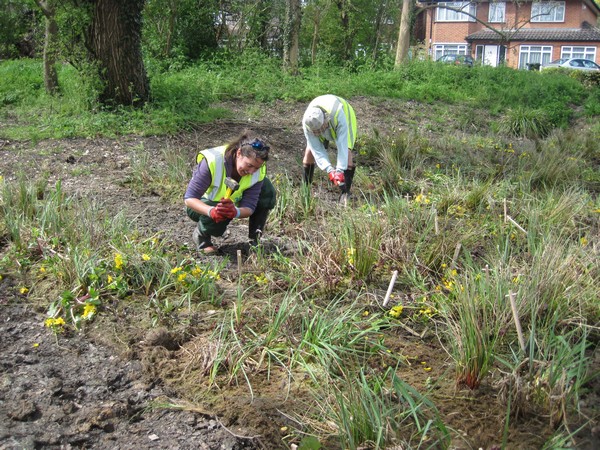 |
| Figure 3. Volunteers planting SuDS components |
Checks must be undertaken to ensure that runoff can flow into and out of the wetlands and any debris in the wetland is removed where it enters the basin. The London Borough of Enfield has agreed to take on the long term structural maintenance of the wetlands, making them sustainable public assets.
Local residents and Thames21 staff also check the stream and wetlands for pollution incidents and report these to the Environment Agency and Thames Water.
Monitoring and evaluation
The initial aim of the project was to improve water quality, and therefore, a comprehensive programme of water quality monitoring has been undertaken. Samples were taken from the stream, above and below the wetlands. Most analysis was carried out in Thames21’s own lab facilities, and as far as possible on a fortnightly basis. Temperature, pH, conductivity, dissolved oxygen, total nitrogen, nitrates, ammonia, phosphates and coliforms were measured. In addition some sampling of heavy metals and surveys of macroinvertebrates was carried out. Results were analysed by qualified staff, and volunteers, at Thames21, and verified by sending samples to accredited laboratories. In addition a partnership with Brunel University monitored Total Petroleum Hydrocarbons (TPH) and Chemical Oxygen Demand (COD). Full reports are available on request to Thames21.
Questionnaires surveyed the public’s perception of the waterways and selected sites before works began, and their awareness of urban water quality issues. These surveys are due to be repeated to determine the perceived impact of the scheme by the public.
Benefits
Impressive water quality improvements were evident for these wetlands. Statistically significant differences were recorded in several important parameters, with average reductions of up to 67% of ammonia, 68% of nitrate, and 55% of total nitrogen. Phosphate concentrations were reduced by 23%.
Significant improvements in coliform bacterial count were demonstrated. Although EU bathing water standards aren’t applicable to the stream, the classification improved from imperative at the inflow to good at the outflow of the system. The system performed well in terms of organic content removal with an average Chemical Oxygen Demand (COD) reduction during a 5-month sampling period of 61.3%.
Invertebrate score under the Biological Monitoring Working Party increased at the sampling point after the wetlands. In 2014 this location scored just 6. In 2016 this had increased to a score of 21.
At the start of the project Glenbrook was an area of thick woodland choked by bramble and fly-tipping, attracting anti-social behaviour. The stream was hidden away, heavily polluted and unloved. Now the site has new attractive features of a chain of wetlands enveloping a cleaner stream. Opening the tree canopy has allowed more diverse ground flora to flourish and already new species are seen visiting the area. It is much more welcoming and a safer place to be (see figure 4).
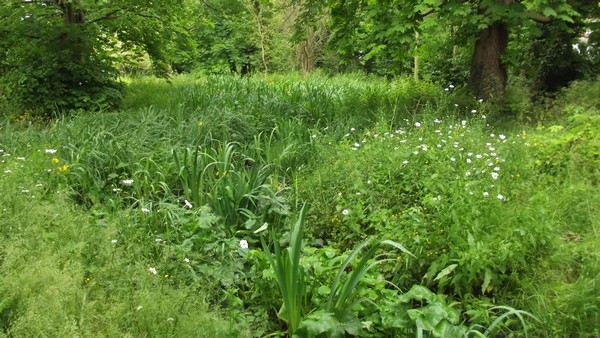 |
| Figure 4. Completed project |
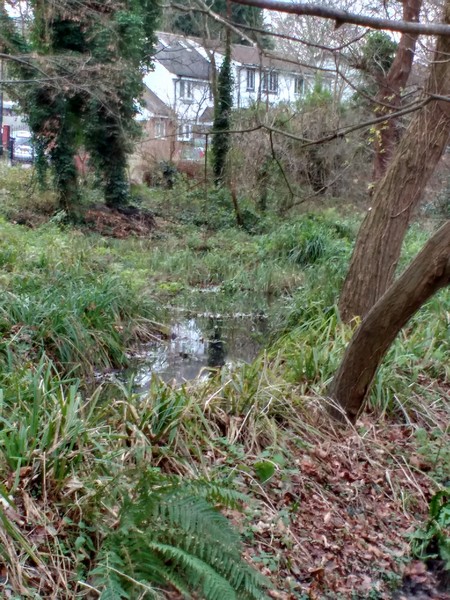 |
| Figure 5. Completed project (Sue Davey) |
These wetlands were the first intervention implemented as part of the Salmons Brook Healthy River Challenge, and were a catalyst for more actions which now sees nine SuDS schemes across Enfield. The project has come from grass roots, from citizens to charity, to public sector and now the private sector are taking note of the need to protect our urban rivers.
Lessons learnt
Construction of the system was complex and works took much longer to than expected. The main reason for this was an underestimated impact of storm flows on the system from the 42ha paved catchment. This resulted in a high amount of erosion to banks and basins, and the undercutting of weirs, issues which took additional time to be resolved.
Although the original plug plants gained good growth in the first few months, winter storm flows also washed out almost all of the original plants. These were then replanted in early spring 2015 with coir pallets which are more resilient and thriving in all but the most polluted first basin.
Levels of pollution here were consistently much higher than expected. Ongoing work with the Thames Water misconnections team has been underway since 2013. Pollution challenged plant growth in the first basin and also impacted on the acceptance of the scheme in the local community. These urban catchments face big issues with plumbing misconnections.
Interaction with local authority
Working in partnership was key to the project’s success. A steering group was formed from Thames21 and London Borough of Enfield (LBE) Structures and Watercourses team, along with others. This provided a broad scope of experience and knowledge, guiding the process of planning and design, and helping with issues encountered in implementation of the initial sites.
Support from numerous council departments was forthcoming, especially Parks and Highways. The Environmental Health Department at LBE has been proactive in visiting properties jointly with Thames Water and following up outstanding misconnections, ensuring these are rectified.
Project details
Total costs: aprx £60,000 (including design and construction)
Planning began September 2012
Construction and operation summer 2014
Replanting to replace losses soring 2015
Planning began in September 2012.
Construction and planting took place in summer 2014, at which point the system became operational.
Re-planting to replace losses was undertaken in spring 2015.
Project partners (and funders)
London Borough of Enfield
Environment Agency (advice and funding)
Thames Water (support and funding for latter parts of the project)
Thames21
Project team
Project management and engagement: Thames21.
Landscape architect: Robert Bray Associates
Contractors: Maydencroft
Maintenance: Thames21 working with local volunteers



